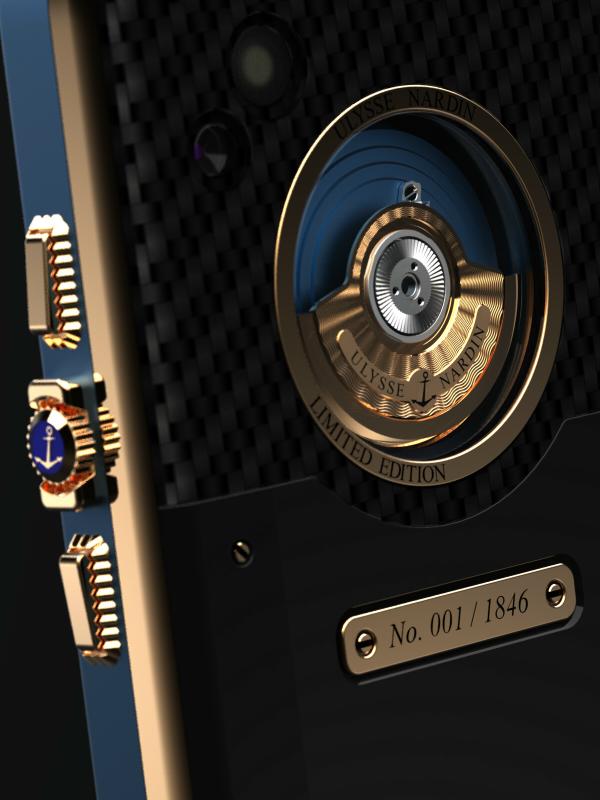Mar
12
I Miss my Treo
March 12, 2010 | 3 Comments
Last year, I retired my Palm Treo 755. It was a sad moment for me, but I felt that, with the new WebOS on the Pre and Pixi, PalmOS was a dead platform, and I needed to move on. I’d been using PalmOS for a long time, having originally carried a Palm V way back when they were new. I feel like I’m missing a friend now. Read more
Apr
14
Steampunk phone: want!
April 14, 2009 | Leave a Comment
Folks who know me in the real world (there’s a real world, I hear some of you cry) know that I have a fondness for anachronistic technology. I’ve got a 10 MB hard drive, a mylar tape, and an actual 64K core board (ask your father if you don’t know what this means). I also repair watches as a hobby. That’s what got my attention about this absolutely amazing looking phone from Ulysse Nardin.

the handset {…} will incorporate a visible, fully-functional kinetic rotor that will apparently assist in providing power, just like you might find in a mechanical wristwatch.
And, yes, they’re serious about that “No. 1 of 1846” business, they’re apparently not making many. No really, if you want to get me one for my birthday, I wouldn’t object…
Feb
24
Code of Second-Life Conduct?
February 24, 2009 | 2 Comments
I’ve been aware that one of the teams at my current client has been experimenting with using SecondLife for their collaborative space. The project is coached by one of the other agile coaches, and I admit I’ve been curious to see what it looked like. I’ve been aware of SecondLife for a while now, but never seemed to get around to creating an account or doing anything more than saying “Huh. That’s interesting.”
Today I got a chance to see SecondLife in action. The coach, who sits by me when we’re not off coaching teams, was logged in and showing some of the other agile coaches what it was like. It was really interesting. They’ve built themselves a custom story wall widget, they’ve got a secured building on what seems like a private island, and they were, by chance, having a meeting with some of their stakeholders when we were there.
SecondLife seems like a very compelling idea. More live than an IM link, somehow more tactile than a conference call. We watched for a while, and then the next time I looked, one of the other avatars was dancing. On the conference table. Well, it’s just a virtual conference table.
I’m not big fan of political correctness myself, but I was a product of corporate America in the 1990s, so I got trained in what some people consider “hostile work environment.” It really doesn’t take much.
At first I was just bemused by the dancing, but a little later in the day I started to think to myself that it certainly wouldn’t be acceptable conduct to dance on a table in a conference room in “first life,” if you will, but it seemed just fine in SecondLife. I mentioned it to the coach who was using SecondLife, and he told me that they had been obliged to sign a document attesting to their understanding that the code of business conduct extended to SecondLife as well.
“But hey! It’s just virtual, right?” I suspect that we’re in for some interesting times, my friends. As we live more and more in the virtual world, I suspect that courts will view them in much the same was as the original: harassment and other misdeeds, even if virtual, will be something the courts will have an interest in. Will codes of conduct be viewed as applying to the virtual world? I suspect so, but I think things will be interesting to watch while this get sorted out.
Feb
4
RFID Wardriving
February 4, 2009 | Leave a Comment
A copule of years ago, governments around the world began deploying RFID enabled identity documents, including passports and drivers licenses. Knowing this was coming, I renewed my passport before RFID was included. I’m a paranoid geek, but then I’m an IT security guy, so paranoia is part of the job description.
Last week, Geeks are Sexy reported that a fellow in California decided to prove the point.
By hooking a $250 Motorola RFID reader and an antenna to his laptop, Chris Paget was able to easily harvest and clone multiple RFID identity documents while driving through San Francisco.
It’s certainly convenient for travelers and for governments to be able to read passports and other identity documents without us having to present them, but this sort of thing violates one of the basics of information security, namely confidentiality. If the information in question is out there in the open, without any sort of controls on who can read it, should we really be surprised when someone decides to read it? Geeks being who we are, we’ll do this sort of thing, or bluetooth sniping, or some other unintended but obvious use of the information that’s floating around.
I’d like to think that governments would have a stake in making sure that our identity information is secure, but most of my arguments seem pretty hollow in my ears. Does it cost them money in lost tax revenue? How about investigative costs? Aren’t they supposed to uphold law and order? My fear is that all of these pale in comparison to the ability to monitor people without their being bothered. My more paranoid self says that RFID enabled passports, drivers licenses, and cell phones could be turned into an awesome tool of a police state. Your location would be known at every moment. Heck, every month I print out my iPass tollway traffic so I can expense it for the business. Who else has access to this information?
Advocates of government surveillance frequently ask us “what do you have to be concerned about if you’re not breaking the law?” They say “We’ll only use our powers for good.” My latest response has been to point them to the reports last year regarding NSA eavesdropping on American soldiers calling home and having steamy conversations with their significant others. In fact, here’s a good case in point. We have a policy of “Don’t ask, don’t tell” in the armed forces. Homosexuality is not technically illegal, but if it comes to light, a soldier can be discharged. What would happen if the NSA eavesdropped on a call between a male American soldier and his boyfriend back home? I’m sure it would be great consolation to him that the government only eavesdrops on us for our own good.
Sep
29
Man Flies English Channel on Mini-Wing
September 29, 2008 | Leave a Comment
Well, if we can’t have our flying cars, maybe we can use these mini jet wings to fly to and from work. I’m really interested in this sort of thing since my commute has gotten a bit longer lately.
Yves Rossy flew 22 miles from France to England in 13 minutes. He leapt from a plane a mile and a half from the ground and fired up his jets. He managed to get across to England without any problems and parachuted into a field beyond the famous white cliffs of Dover.
Man flies across English Channel with jet-propelled wing [via Geeks Are Sexy]
Sep
29
Silverwolf Rubber Band Gun
September 29, 2008 | Leave a Comment
In my continuing efforts to provide my readers with all that is good and right with the gadget world, I present the Silverwolf Rubber Band Gun:
Based on Metal Gear Solid 4, The “Silver Wolf” semi-automatic rubberband gun is made out of shiny stainless steal and features a laser targetting system, allowing you to devastate your colleagues at that next office war.
The Amazing “Silver Wolf” Rubberband Gun [via Geeks Are Sexy]
Jul
30
Nerf Vulcan Automatic Dart Gun
July 30, 2008 | Leave a Comment
I love Nerf guns, and I really miss working in an environment where cubicle warfare is a remote possibility. Working as a consultant, it’s simply not possible, unfortunately. I’d always thought that the Nerf crossbow was the pinnacle of Nerf-dom, but imagine my delight when I discovered that those witty Nerf engineers have finally brought out a fully automatic Nerf!
Nerf Vulcan Fully Automatic Dart Gun Now Available [Gizmodo]
Jun
5
Robot Monkey Brains, Please
June 5, 2008 | Leave a Comment
Caltech scientists have developed a way to create a brain implantable controller, which they currently can place in simian brains. “So what??” I hear you say. “We’ve had implantable brain interfaces for a while.” Yes, yes grasshopper, but this one is really tiny, and can adjust itself to get the best signal after it’s implanted.
They’ve figured out the mechanics, they’re just waiting for the software. How cool is that?
[ Primidi.com via Engadget
]
Mar
26
Paper Enigma
March 26, 2008 | Leave a Comment
During World War II, the Germans widely used several variants of the Enigma machine, which was actually created by a Polish inventor. This same Polish inventor helped the British with their famous project to crack the Enigma, and run by Alan Turing and centered at Bletchley Park.
The basic theory of the Enigma was that you had a number of wheels that had contacts on each side. If you picture a donut, think of sprinkles on both sides and you’ve got the basic idea. Now, if you connect a sprinkle on one side with a sprinkle on the other, but don’t go straight through the donut, you get a degree of obfuscation.
Stack three donuts side by side. The analogy goes a bit awry here, because imagine that we assign each of the sprinkles on each side a letter or number. We pick the letter we want to encode on the left donut, and then run a current through that sprinkle, and you get a current coming out in a pseudo-unpredictable sprinkle on the donut on the right, corresponding to the encoded letter or number. Each time you do encode a character, you rotate the donuts one step. The outer donuts you rotate towards you, and the inner one away. Now run the next current through. That’s how an Enigma works. Here’s an exploded view of an Enigma machine rotor, created by Wapcaplet in Blender.

Later versions of the Enigma added a fourth rotor, and some used reflection, which ran the signal back through the rotors once it reached the right hand side.
If you want to try your hand at an Enigma, and don’t want to machine one yourself, Mike Koss has created a nifty paper Enigma for you to try.
Mar
4
Using CPU Heat to Cool CPUs
March 4, 2008 | 1 Comment
I’ve been wading through tons of announcements of new cameras, cellphones and monitors of late, and very few things have grabbed my attention, but the idea of using the heat from a CPU to power a Sterling engine, which in turn powers a fan for the heat sync seems deliciously ironic.
Of course, as the fan cools the heatsink it deprives itself of energy, supposedly the piston affixed to the crankshaft pulls back down, giving it another potential surge when its heat rebuilds.
[via Engadget]
keep looking »Blogroll
- Ars Technica
- Dark Reading - IT Security
- Help Net Security
- InformIT
- SANS Internet Storm Center
- Schneier on Security - Dr. Bruce Schieier’s blog
- Security Info Watch
- What to Fix - Daniel Markham, fellow consultant
- Wired Gadget Lab
- Wordpress Documentation
- WordPress Planet
- Wordpress Support Forum

